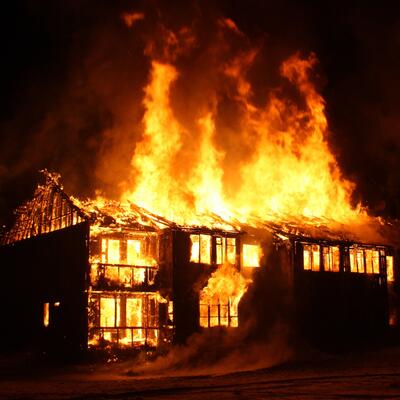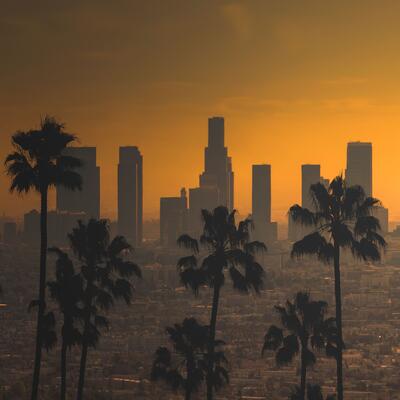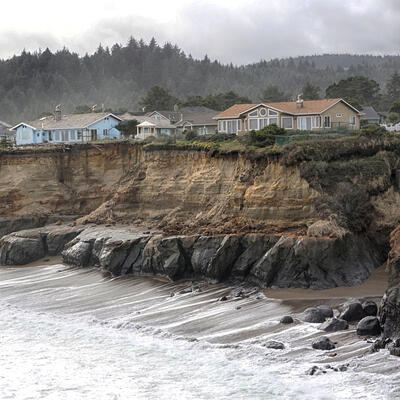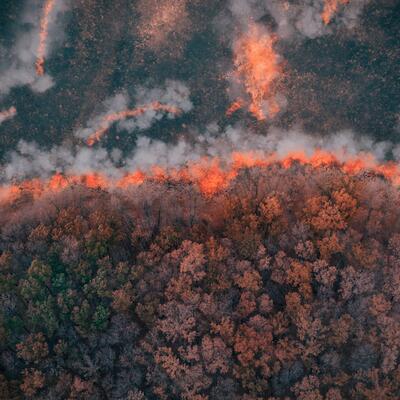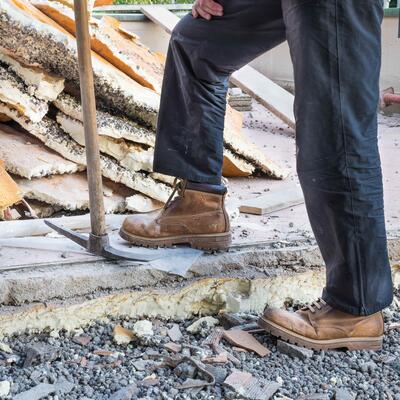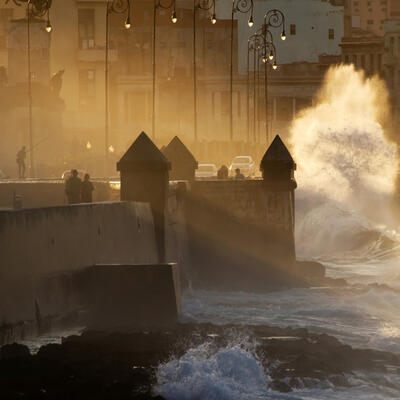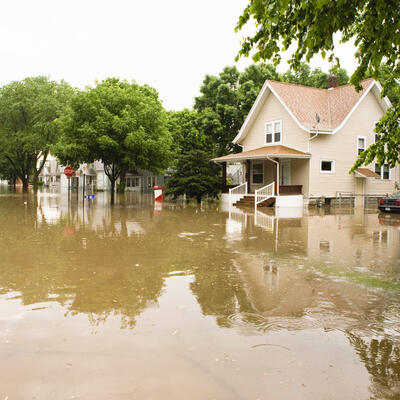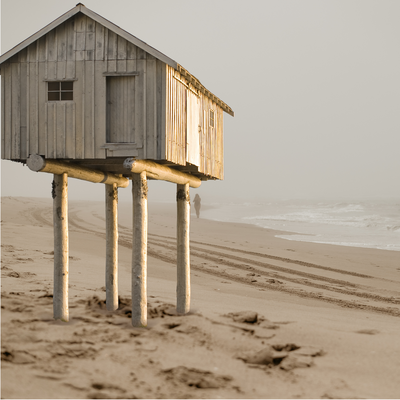
Adaptation: When Prevention Isn’t Enough
Guests
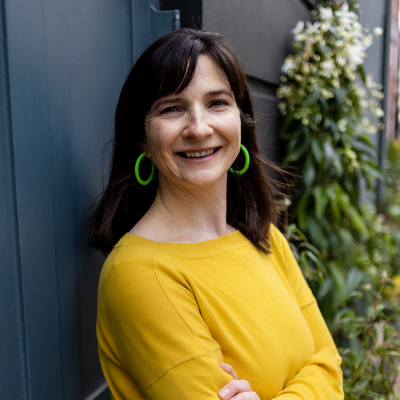
Susannah Fisher
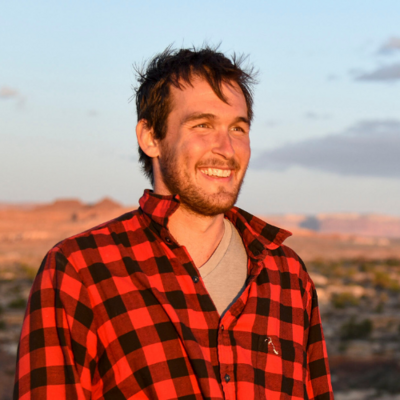
Nick Mott
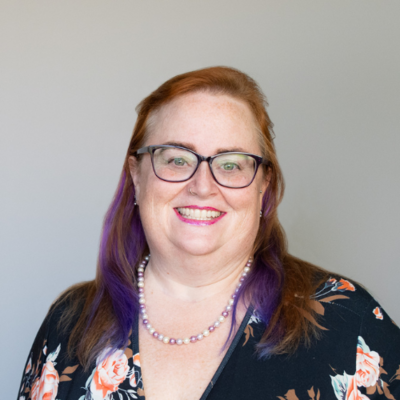
Tanya Gulliver-Garcia
Summary
This episode features a field piece by David Condos, who originally reported the story for KUER in Salt Lake City, Utah.
So much of the conversation about the climate crisis focuses on prevention. But no matter how well we succeed on that front, climate-induced disasters are already causing hundreds of billions of dollars of damage worldwide every year — not to mention destroying livelihoods and causing deaths. We're seeing those impacts today, and we need to be ready.
“Even if we were to stop burning fossil fuels tomorrow, we've baked in enough damage into the system that we're gonna have to adapt,” says Susannah Fisher, Senior Research Fellow at King’s College London and author of “Sink or Swim: How the World Needs to Adapt to a Changing Climate.”
Adaptation does not mean giving up on trying to rein in heat-trapping pollution, it’s “facing the reality of where we are and doing what we can on all fronts to make a difference,” says Fisher.
Some efforts to adapt can be small-scale and personal, but Fisher says some people will need to go through more transformational change, like uprooting their lives from areas of climate danger — like coastal towns — and move somewhere less risky.
“We need to really rethink the system that people are living in,” says Fisher. And that will mean hard choices, like who should be allowed to cross borders because their home has become unlivable?
“As we see around the world, migration is a really hot and difficult topic right now. And host countries and cities are really feeling the strain,” says Fisher.
The global food system is a huge source of planet warming emissions, and it's a system ripe for transformative adaptation. Does that mean we’ll all be eating insects as food gets scarce? Fisher says probably not, but “we're gonna need to think about where we grow food and what we grow and how we consume protein in a way that will be suitable for the global population.”
While Susannah Fisher focuses on adaptation on a systemic level, there’s also a lot we can do on a local, or even personal level.
“We need to think about ourselves as protecting our homes — and not just ourselves as individuals — but ourselves as community members,” says Nick Mott, multimedia journalist and author of “This Is Wildfire.”
Mott says that making a home more fire resistant is one area of adaptation where everyday people can make a difference.
“Think about both your house and then your whole yard. Everything surrounding your house,” says Mott. How close is the nearest tree? Is your roof made of wood? Questions like these can help diagnose problem areas that help fires spread, and allow homeowners to help protect not just their own homes, but their neighbors as well.
When disasters strike, professional first responders are often stretched thin. And help will most likely come from one’s own neighbors. “Mutual aid is really about saying, Hey, what do you have to offer in a community,” says Tanya Gulliver-Garcia, director of learning and partnerships at the Center for Disaster Philanthropy.
When it comes to getting involved, Gulliver-Garcia says that in most communities, some form of mutual aid group already exists. If not, “Get a few people together, talk to your local faith communities, find out what their needs are and start small.”
Episode Highlights
04:06 - Susannah Fisher on her findings as a research student
07:43 - Susannah Fisher on transformational changes
11:52 - Susannah Fisher on the realities of climate migration
17:41 - Susannah Fisher on the future of adaptation
22:47 - Susannah Fisher on international cooperation
27:01 - Susannah Fisher on surprising connections
30:35 - Nick Mott on who is responsible for protecting your house
33:09 - Nick Mott on the next level steps for protecting from wildfire
39:58 - Field piece by David Condos on reusing sewage water
44:38 - Tanya Gulliver-Garcia on what mutual aid is
48:20 - Tanya Gulliver-Garcia on a mutual aid response to climate disasters
53:35 - Climate One More Thing
Resources From This Episode (4)
Full Transcript
Note: Transcripts are generated using a combination of automated software and human transcribers and may contain errors. Please check the actual audio before quoting it.
Kousha Navidar: Okay. Ariana. I don't know if it's because Halloween is coming up or this is just how my mind works, but the more I think about today's episode, the more I think about zombies.
Ariana Brocious: Zombies,
Kousha Navidar: yeah.
Ariana Brocious: Um, okay. That's kind of weird. Kind of specific. What about zombies?
Kousha Navidar: Okay. This week we're talking about adapting to the effects of the climate crisis, and my mind keeps going back to zombies and the movie Zombieland, have you seen it?
Ariana Brocious: I have not. So I'm gonna need you to, break this down for me.
Kousha Navidar: I'm sure you're not alone. If anyone else is listening, they're probably thinking the same thing here. The opening scene of Zombieland is the main character through a voiceover, walking the audience through his rules on how to survive a zombie apocalypse.
[Zombieland Clip]
And why am I alive when everyone around me has turned to meat? It's because of my list of rules.
Ariana Brocious: Okay. Like what rules?
Kousha Navidar: Thank you for asking. Work on your cardio. You don't know when you have to outrun zombies. Be aware of your surroundings because. Zombies in any room know where the nearest exit is because. Zombies
Ariana Brocious: because that, yeah, that seems like good advice for a zombie apocalypse, what does it have to do with climate?
Kousha Navidar: Yeah. To be clear, the climate crisis – to our knowledge – does not cause zombies. But in the movie, the character is adapting to his new zombie reality with actions that he can take. But he's also facing a systemic threat of whatever turned people into zombies, and he's working to try and figure out how to prevent more zombies, maybe even reverse what was causing zombies in the first place.
Ariana Brocious: This is, this is clicking for me now. So you see this as an example of how people can adapt to a new reality like climate disruption while trying to simultaneously fix the root problem that's causing it.
Kousha Navidar: Ariana? You got it. Thank you. I feel seen.
Ariana Brocious: All right. That's a decent example. I’ll give it to you.
So today's show is about how adaptation relates to the climate crisis. It's not about zombies, sorry. I'm Ariana Brocious.
Kousha Navidar: I’m Kousha Navidar.
Ariana Brocious: And this is Climate One.
Music: In
Ariana Brocious: So much of what we talk about on this show is about prevention when it comes to global heating – basically, how to reduce the tons of climate-disrupting pollution humanity is putting into the atmosphere. But this week we’re going to talk about ways to adapt to an already changing climate.
Kousha Navidar: Right, we are already facing the effects of the climate crisis – stronger hurricanes, more intense wildfires, more frequent flooding. The list goes on. And there are things we can do to help make these events less devastating, and even less deadly.
Ariana Brocious: For years, many in the climate conversation were hesitant to even talk about adaptation, because it was kind of seen as giving up, or taking attention away from the prevention side of the equation.
Kousha Navidar: This is often about money. We can’t spend money on everything because it’s finite. And I get how it might be seen as a zero sum game – where if we spend more money on, say, building seawalls, that means less money for building batteries to make a solar farm work around the clock – and we probably also need to do that as well.
Ariana Brocious: But that’s not how I see it. Maybe it’s a generational thing – for those a bit older it has always been about prevention. For those my age and younger, climate disruption is HERE. This is our reality, and not going anywhere. So to me it’s not binary, it’s both – we have to adapt and still work to prevent things from getting even worse. And adaptation can be creative, empowering, resilient, not dark.
Kousha Navidar: There’s a new book out called Sink or Swim: How the World Needs to Adapt to a Changing Climate, by Susannah Fisher. She’s a Senior Research Fellow at King’s College London. And this book really prompted us to do this episode – because it challenged us to think about some pretty tough questions.
Ariana Brocious: When Susannah Fisher was a research student, she spent a year traveling around India trying to get government officials to talk about what they were doing in regards to climate change. But she didn’t find them making much progress.
Susannah Fisher: I think climate change felt like a distant problem. But I think what's less obvious, although it's much more talked about now, is how climate impacts are gonna affect how people live their lives. And although a city might in India might feel like, gosh, there's so many people living in poverty, we can't worry about climate change. What we know is that the climate risks are gonna make their lives even more difficult. So it will be an important thing.
Kousha Navidar: Yeah. That's the irony there. A lot of those communities are often the ones that are on the front lines of climate disasters, flooding, extreme heat. So how did that response from the government sit with you personally or emotionally?
Susannah Fisher: Well, I really understood their response in terms of the context they were working in. But I think it's something that's built up for me over time, because then I started working on adaptation projects in other countries and it always just felt like too small compared to the scale of the challenge. And in my life I go between reading research reports and then going and working with people, kinda dealing with this is on the ground. And there was just always this huge divide between the scale of the impacts that you'll read in the international reports on climate change, and then the reality of what people can do when they're facing so many constraints in their local environment.
Kousha Navidar: I am happy that you brought up adaptation because I wanna dive into that. So those working on climate policy tend to focus on like quote unquote mitigation, which really means taking preventative measures like reducing the burning of oil or gas and coal or on, on another side of it, there's adaptation, which means preparing our communities to better weather the increasingly frequent disasters. And obviously we need both. But you've said you've chosen to focus on adaptation. Why is that?
Susannah Fisher: Yeah. So mitigation and reducing greenhouse gas emissions is absolutely crucial. So I really support everyone involved in that fight, and I do what I can, but my, yeah, my work really focuses on what do we do about the impacts, and that's because unfortunately, even if we were to stop burning fossil fuels tomorrow, we've baked in enough damage into the system that we're gonna have to adapt to the impacts of climate change. And mostly the people who are gonna be most affected are, as we've talked about, the people who are structurally already disadvantaged, living in poor housing in their cities or on the edge of a coastline. And so I think it's really important to help think through what, what will good look like for those communities in the future in the climate change world? And that's what adaptation does.
Kousha Navidar: Where the damage is already baked in. An element of that does sound a little bit like giving up. Does the very idea of adaptation mean that we have to lower our expectations?
Susannah Fisher: No, I think it's really important we don't think about adaptation as giving up, and that's why I said at the beginning that we have to mitigate and we should focus a lot on reducing emissions, but it's inevitable that we are already experiencing it in the uk. We had the hottest summer on record this year, and we had four heat waves as well. and we had wildfires across Europe, hurricanes last year. So all of these things are being influenced by climate change. So it is not a question of giving up, I think it's facing the reality of where we are and doing what we can on all fronts to make a difference.
Kousha Navidar: Before reading your book, I thought of adaptation mostly in terms of incremental changes. Like, I don't own a home, but people hardening their homes against a possible storm or wildfire, like having construction workers shift their hours to extreme heat. You know what I mean? But one thing I found very gratifying from your book that I really interested me was this idea of transformational changes. So what does that look like?
Susannah Fisher: So transformational change is really saying sometimes we need to really rethink the system that people are living in or the values that people have about the life that they're leading, and really reexamine that. And there might have to be really quite a fundamental change. So when we talk about incremental adaptation, we might be talking about something like as you say, changing your hours as you're a construction worker in Europe, but you can still do the same job. You are just slightly tweaking it. Or perhaps you might put better kind of ventilation into your house to deal with the heat, but your life is still the same. But transformational adaptation would be, gosh, you are living in a small town in a coast and the sea defences just aren't keeping the flooding back anymore, and maybe you're actually gonna have to relocate and find a whole new life somewhere else. Or maybe you've been always growing a certain type of crop if you're a small holder farmer in Sub-Saharan Africa, but actually that's just not working anymore and you have to change the whole way that you earn your livelihood because of climate change. So those kind of really big changes are what I would call transformational adaptation.
Kousha Navidar: And hard choices.
Susannah Fisher: Yeah. So, so what I argue in the book is that there are really hard choices behind transformational adaptation. It's not very easy to change your life and probably most people don't want to unless they really have to. And there are often trade offs. So for example, something that might feel really good in the short term, like staying where you're living next to the sea, might actually not work in the medium term. So you have to take a short term cost. It's also really politically difficult as well, not just for the residents, but for the local politicians. No one wants to make that call to move people away from their homes, but there is the longer term risk that they're gonna face. So there's so many difficult choices and compromises that have to be made along the way. That's really hard to face up to.
Kousha Navidar: Yeah. Susannah, that's a part of your book that I found really interesting 'cause it is the hard choices that often are the bottlenecks to making the changes that a community might need long term. I wanna dive into one of those. 'cause there are questions like, who bears the cost and benefits of shifting a zone for agriculture, for instance, or like, which ecosystems should we prioritize? And I wanna give listeners a chance to like, dive into one of these a little bit to get a taste of what it's like in your book. So let, an example that we can talk about which you and I talked about ahead of time was, should people have the right to cross borders due to climate change? Can you unpack that for us? What's at play there?
Susannah Fisher: Yeah, sure. So most movement at the moment from climate change is within borders. So although we often talk about international migration, climate related movement is often at the moment within borders, but as the impacts increase, people may need to move across borders, and that might become a bigger part of their decision making process. Now, at the moment, if you were to move across a national border for climate related reasons, you wouldn't really have any protection or any legal status beyond what was there under the regular agreements. So in the book, I'm posing the question, well, if people do really have to cross move borders because their lives have become unlivable or places potentially become uninhabitable 'cause the risk of climate change, do we need to rethink like what gives people the right to go across. A border and to have the right to a life somewhere else. And of course this is really tricky because as we see around the world, migration is a really hot and difficult topic right now. And host countries and cities are really feeling the strain also on their public services of having new communities there, not having the resources to support and work with them. And obviously politics has also really pushed down on migrant groups. So it's such a tricky political issue, but it's something that I think climate change will continue to force us to confront what would give people the right to move across borders and what would good movement look like in a safe and dignified way to allow people to respond.
Kousha Navidar: If global temperatures go up by just two degrees Celsius, then as many as 3 billion with a B, people won't have enough water to meet their needs, and climate disruption is already driving migration. I can't fathom what moving 3 billion people would look like.
Susannah Fisher: Yeah, that's huge. I think that it's, these big numbers are really tricky to understand, but also I think it's, we're not talking about 3 billion people potentially moving across borders. I think we're talking about 3 billion people who might need to make changes within their local communities or move, for example, from rural to urban life in their own country. And the numbers around people needing to move are also really tricky to calculate because we just don't know how the impacts will play through, but also the choices will pay, people will make in response to that,
Kousha Navidar: What about on the political side? Like do you think we as humans are this is gonna sound kind of cynical, but like, are we capable of making those kinds of long-term bets when politicians are often thinking about the next election? I know that's very reductive, but can you just unpack the political aspect of it for me
Susannah Fisher: Yeah, across the book I talk about these choices and it's clear we need to take a longer term vision and we need to think about the collective good in some senses that, if one country or one community is safe, it will mean better security for others as well. So we are all in this together, and that's often against the direction of current politics in some countries. And so I'm asking myself, what would it take for us to be able to make longer term decisions and how do we build those incentives in? So I think it's partly about changing how we understand the cost benefit of policy choices, for example, because now we don't calculate those longer term risks and costs. So everything also always looks cheaper. But in the longer term, many of these choices like match work out to be much more effective. And then I think there's the question of who we include in those decisions to make them longer term. Can we include children, youth groups, people who've got that longer term perspective? But it is a really big challenge to how our current systems work. But we have to find a way of addressing it because this is really the question of our time.
Kousha Navidar: Yeah, absolutely. I remember in policy school learning about the idea of net present value and trying to see what the baked in utility of a future outcome is. And it is, on paper there's a mathematical equation that kind of makes sense, but. Besides insurance, which is about losing something and harboring yourself against that, it's so hard for the human brain I feel to truly appreciate what has not yet happened versus what's right in front of you.
Susannah Fisher: Yeah, absolutely. And to price that in into your decision making now is so difficult to make it a priority when there are so many other priorities. But I think there've been some interesting experiments when they've done things like citizens assemblies or groups with people where they've met with them multiple times and talked them through all the different climate impacts. People, those kind of groups of citizens do start to make longer term choices. I think one of the issues that we face is people receive very limited information on these issues. They don't have time to think about it, and you're onto the next thing. But actually, when people make quite long informed decisions they are able to prioritize the longer term. But so much of our political system is not built for those conversations.
Kousha Navidar: Yeah. So how would you personally answer the question? Should people have the right to cross borders due to climate change?
Susannah Fisher: Great. Put me on the spot
Kousha Navidar: Yeah, sorry about that.
Susannah Fisher: I think we should develop systems that allow some migration routes for climate reasons. So I think it will be really hard to do because people move for so many reasons and climate change will be one of them. But I think if we had some safe and dignified routes between certain countries that relied on a climate reason, that would be a good adaptation strategy for the future.
Kousha Navidar: Another area that needs transformative change. That really strikes me as agriculture, global food systems are a cause and themselves will be impacted by climate disruption. And you talk about this to unpack it a little bit, will we all need to start eating insects?
Susannah Fisher: So the food system is super challenging from a climate perspective because as you said, it's a huge cause of emissions. It's also a huge cause of biodiversity loss, but we also need to adapt to it because the way it currently works is just not gonna be fit for the heat waves and droughts of the future. So yeah, we're gonna need to think about where we grow food and what we grow and how we consume protein in a way that will be suitable for the global population. So if we're all gonna eat insects, I'm not gonna guarantee that they're gonna be on the menu at McDonald's, but I think that we are gonna need to ease a wider variety of things. We're gonna need to, yes. Like, think about new grain varieties, things that have fallen outta fashion, old grains, new types of protein because we just need to have a much more diverse food system, both in terms of what we can get locally, but also the way that we trade food. We're gonna need to have a much kind of broader range of places that we get food from so that when there's a shock in one part of the system, another part can respond.
Kousha Navidar: Yeah. There's another part of your book, not like a chapter, but a general theme of your book that really strikes me that I wanna be sure we talk about, which is the sink or swim sections where you envision the world 45 years in the future and you present two different scenarios. There's one where we proceed with business as usual between now and then, and there's the one where we get it right or make the hard choices. Let's look at one example and maybe you can unpackage it for us for listeners. So staying with food systems, what does the world look like in 45 years? If like, let's go down the business as usual path, right? So what is what does almost half a century from now look like?
Susannah Fisher: Yeah. So if we don't adapt and climate impacts continue to escalate, I imagine a scenario where, so where we can grow agricultural land starts to shift. So much of the land across Sub-Saharan Africa, south Asia starts to become really difficult to grow crops there. So it becomes more barren. People start to move out. Actually the area we can grow crops moves up into the northern latitude. So I'm imagining a scenario where Canada and Russia are raking it in. They've got new agricultural land, it's brilliant, they're able to grow some crops there, but we've really left behind a suite of the global population who are suddenly finding themselves unable to grow the crops that they used to. And then I'm also imagining there's something called multi breaded basket failure, which is a risk that we'll start to see multiple areas of the world experiencing drought at the same time. And that could become more severe due to climate change. So in a scenario where we haven't done anything about it, we might see multiple staple crops all fail at one time, but if we haven't got any system to manage that, it's gonna be a real scramble to get the food that is available. Prices are gonna massively escalate. Countries are gonna refuse to export and the least powerful in the system are the ones who are gonna lose out. So they're not gonna be able to trade, they're not gonna be able to import what they need and they're not necessarily also able to grow what they what they want. And I think all of this would lead to a situation where vast proportions of the population are malnourished. We're seeing children with, without the nutrition that they need. We'd see supply trains disrupted. You're trying to get your crop in, but it's just getting stuck in the drought or whatever issues coming along. So, a really difficult situation, which would affect. Every country, so it wouldn't be something that people could protect themselves from. Chaos across the food system would be chaos everywhere. then I try and imagine the positive scenario,
Kousha Navidar: Yeah. Well, what's, well, so that's the sink half of sink or swim. There's also the swim part of it. So how do we swim? What, what do future food systems look like if we get it right?
Susannah Fisher: Yeah, so, so then I try and imagine you say another scenario, and it's still a scenario where we're gonna see climate impact. So the question is, how do we respond in a way that's gonna make those, least, least difficult for those who can't manage them? So when I think about the moving space, you. If agricultural land is gonna shift a bit towards the latitude, how do we make that fairer? So would the fossil fuel companies be providing payments to countries or farmers who suddenly lost their livelihoods? Could we have an international tax and regulation regime on the new land that emerges, that forces these countries or regulates them to use it in a certain way that will benefit the global community through, for example, sequestering carbon or enhancing biodiversity. And maybe we need a new kind of international board that would ensure that food systems remain stable. 'Cause we've got a big gap in the global governance of system of food right now and thinking about how, how do we keep this system stable? How to make sure that countries have got enough food. And in times of kind of price escalation. So in a swim scenario when imagining we'd have this new global board of food system stability that would provide that global advice and just help coordinate the response. And then I also think we would see lots of new varieties across the system. So we've talked about one of the issues with the food system being there's quite a few staple crops grown in a few places, and that kind of lack of diversity is a big risk in terms of resilience to climate impact. So let's imagine a scenario where we're all trying the new grain varieties, instead of our regular rice these days, we're all using different wild varieties and probably different in different areas to have great variety across the system. And then as well as all that we'd have a really great social protection system in place. So, where children aren't getting enough food, we'll be able to deliver payments where nutrition is insufficient because climate impacts have hit, say in India for example, we'd be able to supplement through adaptation payments. So although there would be some impacts, there'd be some ways of stabilizing the food system that could make this feel a bit fairer for everybody.
Music: In
Kousha Navidar: After the break, we’ll continue my conversation with Susannah Fisher. Also coming up, how to make your home more resilient to wildfires.
Nick Mott: Even things like building a little walking path in your yard, for example, could be a great way of just having a little barrier that keeps flames away.
Kousha Navidar: That’s up next, when Climate One continues.
Ariana Brocious FOR BROADCAST: You can find hundreds of past episodes on all aspects of climate on our website, climate one dot org. Or, subscribe to our podcast wherever you listen.
Ariana Brocious FOR POD: Help others find our show by leaving us a review or rating. Thanks for your support!
Music: Out
Kousha Navidar: This is Climate One. I’m Kousha Navidar.
Let’s continue my conversation with Susannah Fisher, author of SINK OR SWIM: How the World Needs to Adapt to a Changing Climate.
Adapting to the effects of the climate crisis will require a lot of difficult choices. In many cases, progress will hinge on the ability of different nations to find a way to work together. And that’s where we pick up the conversation.
Susannah Fisher: I think the issue of international cooperation is gonna be really key as we adapt to climate risks because they don't just stay in one country, they inevitably spill across and have all kinds of impacts across different governments. And so it's only with governments clubbing together and looking at those issues that we're really gonna get to the core of it.
Kousha Navidar: And I think that's important to think about because an even bigger question that probably underlies every one of the hard questions is who pays? It's one thing to say that a government in a rich country should pay for better flood control in their own country. But it's another thing to say that rich countries should pay for all the damage they've done to poorer countries that have contributed the least to the problem. So what hope do you have that rich countries will actually pay poor countries anywhere close to the fair compensation for the losses and damages that, that they're continuing to suffer.
Susannah Fisher: Well, I think we can only hope that they will continue to contribute to the system as they are. So as we come up to Brazil, the negotiators will be thinking about the money they're gonna commit. But I think even with a really generous payout from governments. It's just not going to be anywhere near the costs that there are. And I think that's widely acknowledged now within the system. And so it's why governments from the global south and from the developing countries are also looking at things like private finance. What would it mean for the private sector to take on some of these costs or indeed what? What about if we thought about getting the money through other means if we had a tax on shipping on aviation? So there are like a number of different financial mechanisms. I'm not confident that we will get enough just through kind of grant finance from governments. I think it's gonna have to be lots of different way of sourcing the money, but also I think, it's also about using the money that we have better and smarter because lots of money's flowing in the wrong direction. We're subsidizing fossil fuels, we're subsidizing meat production that is not helping with biodiversity and with adapting agricultural land, like the subsidies that are subsidizing us to increase our climate risk of far beyond what we're paying in adaptation in the other direction. So I think we need to really address that as a core issue, as well as putting like new money into the system.
Kousha Navidar: You've worked extensively with governments and climate funds on adaptation planning. What are the biggest gaps between adaptation policy and actual implementation on the ground?
Susannah Fisher: Yeah, it's so challenging because we need more money, but even with the money, there are still gaps in what happens. And even in countries, say like the UK, when we have quite significant budget allocated to this, we're still not really seeing the progress that we need. And there seems to be a big gap between designing your national adaptation plan and then actually implementing it. I think one of the reasons is what we've talked about already is the incentives generally heavily push against addressing future risk. It's not really in anyone's economic interest in the short term to address it. And it's certainly not in say, property developers' interest to think about not building in that floodplain, for example. And no government really wants to take the short term hit. As well as the incentives, I think it's often really hard to engage people in those longer term choices. So, for example, again, in the UK there was a shoreline management plan program run by the government. So they were looking all across the coastline, where are we gonna be able to stay and where might we need to retreat? And the outcomes of some of that planning exercise only came to the towns later through the media. So people had been left outta the decisions. I think we see that in all kinds of places, that there are lots of decisions being made about people's lives and adaptation, but they haven't been involved in them. So of course they're not really keen to go along with it. They resist, they push back. Totally fair enough. So there's also a big issue in how we start to engage like citizens in these questions and help them think through their futures.
Kousha Navidar: You're writing this book in the process of many years of experience across different countries at this kind of 10,000 foot level, right? When you're going back and looking at everything, did anything surprise you as you were putting it all down on paper, like connections that you didn't originally see that kind of came out once you started the process of actually writing the book?
Susannah Fisher: Yeah, well, the chapter that I found most surprising was probably the one on nature. Because those of us working on adaptation, we haven't in the past really engaged much with biodiversity. It's always been a separate issue, but actually the more I got into it, the more I realized that the need to protect biodiversity is so intricately connected with the need to adapt to climate change. And those have been two completely different worlds, but they're so important to each other. And I'd started asking myself these questions about. How, how will animals move? How will we adapt them? And so there's just like so many kind of challenging issues and really interesting things to think about that I hadn't thought of because I had always come to adaptation with a kind of human head on. I've been thinking about the people and of course the people are central to it all, but we can't look up in 2070 and not have any of the natural world around us.
Kousha Navidar: Yeah, I think that's a great point because we just talked about it five minutes ago with different grains of rice, right? Like biodiversity is a climate hardening adaptation for the whole world. I guess the last question I wanna leave listeners with is when you look at the best examples of adaptation measures, what do you wish others would learn from them?
Susannah Fisher: So I think the best examples are places where they've really taken the time to think about what people want for the future. So I think there's many examples of adaptation projects or plans where there's just been a kind of assumption that we'll continue same as we did before and that will work out, but it's not necessarily what people want for their future. So I think adaptation actually really poses difficult questions about how do people want to live in the climate change world? And what does that look like if it doesn't look like it has before? So I, I think there'd been really great examples in countries like Kenya for example, where they've done really like local climate funds, who've really asked local people and worked with them. What does good look like? And how can we fund that and finance that? So I think for me, again, it's about how we bring people along in this question of new futures. And also think about the fact that those futures might be totally different to the ones that are before, but they'll be much more resilient to the climate change future.
Kousha Navidar: Susannah Fisher is a principal research fellow at University College London, and author of the new book, Sink or Swim, how the World Needs to Adapt to a Changing Climate. Susannah, thanks for. Are hanging out with us and for writing this book. I really enjoyed it.
Susannah Fisher: Great. Well, thanks for having me.
Ariana Brocious: Most of what Susannah Fisher spoke about was adaptation on a systemic level. There’s also a lot we can do on a local, or even personal level, to prepare for increasing climate risks.
Nick Mott: Many homeowners simply expect the Forest Service or local fire department to come to the rescue whenever they need it. A century of fire suppression built this expectation. People think managing wildfires is someone else's job. A service the government provides.
Ariana Brocious: Nick Mott is a multimedia journalist and author of “This is Wildfire: How to Protect Yourself, Your Home and Your Community in the Age of Heat.” I talked with him last year about how individuals and communities can help make their homes more fire-safe.
Ariana Brocious: So, how do we need to rethink the balance of responsibility in this current moment in terms of who will protect your home, who should protect your home?
Nick Mott: We need to think about ourselves as protecting our homes, and not just ourselves as individuals, but ourselves as community members. So think about where you live, but also your neighbors and your larger community outside of, you know, your block. when I say think about yourselves, the great place to start is at your own home. And that can mean all kinds of work that can get done. Everything from, cleaning out your gutters of leaves and pine needles to working on fire resistant gardening practices that can help keep fire from coming up against your house if it comes from far away. And then if you look bigger, you know. I live in a fairly dense place. Like, my neighbor's not very far away on either side. So if I have a fire resistant yard, my neighbor doesn't. You know, their house is pretty dense. 20 yards or less away, that's not going to make a huge difference if their house goes up in flames because that residual heat and all those embers can still just, would easily ignite mine. So, it's not just this problem that's purely individual, it's a problem that, where we have to look a little bigger and connect with our neighbors and offer, offer a helping hand at times, offer tools, offer ideas. And build those links that I think we're missing in a lot of ways from, from the individual to the more collective.
Ariana Brocious: hmm. So in the book you have some really great resources that detail What are the things people can do to protect their home? Um, and I'd like to just walk through a few of those now So the home ignition zone, let's talk about what that is and what people can do in that area
Nick Mott: Basically think about both your house and then your whole yard. Everything surrounding your house. And take that together. And think about how fire might start somewhere, even if not on your house, and travel to your house. So it could be an ember lofts into a tree a hundred yards away, and then there's what's called ladder fuel, uh, you know, on this tree, ladder fuel meaning like smaller branches and limbs going up from the ground, and then there's tall grass or shrubs or whatever down below it that could then carry that fire into more trees, into more shrubs, and carry it to your home. The idea is, when we talk about the home ignition zone is to make it so there's not this clear path for fire to burn from farther out to your house and on the sort of envelope of your home itself to make sure that your own home is pretty secure from things like lofting embers that could set it ablaze. Some of the bigger things are, you know, don't have a wood roof that can ignite, so you might need a new roof.
Ariana Brocious: This is what's called home hardening, right? There's sort of like another layer. So there's the stuff you can do in your yard clearing brush and then there's, this next step of like, actually changing the materials on your house.
Nick Mott: Exactly. So on the home itself, you know, you can change out your roof. That's really important. And I think I should also say a lot of these changes also have other benefits. So a new roof isn't a bad idea for all kinds of reasons. And a lot of older homes, you know, other changes like new windows can be good for energy efficiency. new siding can be beneficial as well. But other things to think about are the sort of openings into your house. So like soffits and vents that are often open these places that could kind of suck in embers, put a 1/8th inch screen on those pretty simple, pretty cheap fix, but it goes a long way and sort of sealing up the exterior of your house. Other things to think about is your deck. If you have a wooden deck, there's a lot of vulnerability there. So you could rebuild with fire resistant material. make sure there's not fire prone stuff underneath your deck either. also think about the area. Five to 10 feet away from your house. So if there's wood mulch there, if there's trees like hanging over your roof, you might have to part ways with those trees or at least those limbs. You might have to replace that wood mulch with gravel. A wooden fence can sort of act like a snake and just whip fire right to the side of your house. So think about, you know, that sort of five, 10 feet of offense going up to your house, maybe replace that with something metal or something that's not wood and going to burn right away. As you move farther away, the things to do are less intensive, but it means, you know, spacing out your trees. You might have to change the way you think about your landscape. You might have to cut down some trees, certainly thin trees, space things out more. And think about fuel breaks, so even things like building a little walking path in your yard, for example, could be a great way of just having a little barrier that keeps flames away.
Ariana Brocious: That's great. There's, there's a lot, actually. I do want to say this isn't about making your home impervious to fire, right? Because that's pretty difficult, but it's about giving it a better chance of withstanding fire and helping the people that might be coming to defend your property if you're, you know, in the case of having wildland firefighters do that.
Nick Mott: That's absolutely right. It just gives your home a better shot of surviving. There's an image from Lahaina that went kind of viral after it happened of a home. The sole home that was surviving. And if you look at that house, a lot of the things I just spoke about, had been done there, whether or not that was consciously for wildfire, but it sort of speaks to the real impact those practices can make. But also, you know, we shouldn't rely on firefighters and expect firefighters to defend our property, but if a fire does come and firefighters are coming through the area and are trying to keep fires away from homes, which does happen, there are lots of cases where firefighters will just pass up a home if it's clearly dangerous, if there's clearly no hope of stopping the flame.
Ariana Brocious: Mm hmm.
Nick Mott: If you give them a chance and even, or even give them a safe space, that can make a huge difference in, in what is done for your property when, when disaster does occur.
Ariana Brocious: So this can feel like a lot of work. Right, which you acknowledge. , The end of the day, it's one more thing to add to your list. you do provide some really great lists of how you can sort of start small and knock things off one by one. What you can do in an hour, an afternoon, or a weekend, maybe. How have you found the time to do this kind of work on your own home?
Nick Mott: I’m not perfect. I have a lot of work still to do here. It's interesting because like having a house means there's just this endless sort of tally of stuff that's got to get done. And. You know, putting this stuff into it, I think a lot of the things that are continuous is some of the maintenance work that can be done anyway. Like things like clearing out your, your gutters. That's really important. Other things, bigger projects are just the sort of things you need to think about in the longterm. Like replace your roof when it's time to replace your roof. Don't do it too early. so. And it's not all or nothing. Like every little action you take can make a big difference. So like, don't feel bad for not having done everything you could possibly do. Don't feel bad for not having a perfectly fire resistant shell of your home or yard or whatever. But do you know, think creatively, like at the same time that you're mowing your lawn, be like, Oh, maybe that tree doesn't need to be here anymore. Or, uh, you know, just look at your landscape a little bit differently. Also, like, talk with neighbors. People are excited to help each other. it can become a community norm to have this work done. So there's some nonprofits and communities across the U.S. working on this stuff and what a lot of people find is that like if there's some sign of this work being done, it can kind of go a long way to making it feel like this is a thing you should do in your community in the same way that there's like if you live in an area with say black bears and you have bear resistant garbage as soon as you start seeing that it's like, Oh, maybe I should have that too. If you start seeing like a sign that says, Hey, I replaced my roof. Hey, I did all this work to make it fire resistant. That can make it seem like this is just something to be done. And it becomes part of the sort of everyday nature of this sort of long tally of work you have to do in your home.
Ariana Brocious: And you're also contributing to the wider community safety, which, you know, there's a benefit for everyone about you're making your home that much more defensible. So do you have suggestions for how people can begin to have some of these conversations?
Nick Mott: Yeah, I mean, I would say one of the first things anybody should do isn't necessarily connecting with neighbors, but do find out if there's one of those organizations that's working on this stuff around. You can often get people to come by your house and like audit what you can do and should do. And that's really helpful. Maybe your neighbors will see that and ask you about it. And if you do that, maybe you can talk to your neighbor and be like, Hey, this, this, this, these folks are really great. You should check them out. And it was free. Um, you know, depending on the case that you're in, but you know, every community is different. Every neighborhood is different. And I think just seeing you out there doing stuff like being outside and doing that work on the outside of your house, doing stuff that's visible, putting yourself out there. That's something that's very conducive to talking to your neighbors. There's no single recipe for building community, but being open, being out there is all stuff that's, uh, that can go a long way to building those connections.
Ariana Brocious: Nick Mott is a multimedia journalist and author of This is Wildfire. How to protect yourself, your home and your community in the age of heat. Thank you so much for joining us on Climate One.
Nick Mott: Thanks for having me.
Music: in
Ariana Brocious: Coming up, the most effective climate action you can take is probably local.
Tanya Gulliver Garcia: All disasters start and end locally, climate disasters, no different, it doesn't matter what's causing the disaster.
Ariana Brocious: That’s up next, when Climate One continues.
Music: out
Kousha Navidar: This is Climate One. I’m Kousha Navidar.
In the American West, growing cities, a lack of water and rising temperatures are spelling trouble for the region. But in Southwest Utah, one desert community wants to preserve its water supply, by reusing sewage water.
From Salt Lake City, KUER's David Condos went to find out how the process works, and what it might mean for other cities in the west.
DAVID CONDOS, BYLINE: It started with a simple equation.
ZACH RENSTROM: The math problem is all the water's been used. It's been called for. But yet, we have one of the fastest-growing communities in the Western United States.
CONDOS: Zach Renstrom manages the Washington County Water Conservancy District in St. George, Utah. And in 2021, this sun-drenched outdoor recreation hub was the fastest-growing metro area in the country. But an answer to its math problem may now be taking shape.
(SOUNDBITE OF POWER TOOL WORKING)
CONDOS: Renstrom points to a maze of rebar and concrete that's slated to become a new wastewater recycling plant by the end of this year. It'll take sewage and to clean it with screens, bacteria and UV light.
RENSTROM: So basically, the water will come into there.
CONDOS: Reusing wastewater is the biggest piece of the district's long-term water plan. In all, it'll cost over a billion dollars. Renstrom knows that's a lot of money for a place with 200,000 residents.
RENSTROM: But now we're getting to the point where even small communities like us, it's our only option, and so we just have to do it.
CONDOS: More and more western cities are facing this dilemma as people keep moving in and climate change makes heat more intense and rain less reliable.
(SOUNDBITE OF BIRDS CHIRPING)
CONDOS: A visit to St. George's main water source, the Virgin River, highlights the urgency.
DOUG BENNETT: This is it. This is the lifeblood of the entire region.
CONDOS: Doug Bennett is the district's conservation manager. Now, this river may have carved the canyon in nearby Zion National Park, but after a dry winter, it's shallow enough to walk across without getting more than our ankles wet.
(SOUNDBITE OF FOOTSTEPS)
CONDOS: In addition to reusing water, St. George and neighboring cities have adopted rules nearly eliminating grass on new development. The district pays residents to rip out their lawns, too. Making growth sustainable here will be a tall task, but Bennett believes it can work. He saw it in his previous job at the water authority in Las Vegas.
BENNETT: I have to have a lot of faith that it is absolutely doable because I've already experienced that.
(SOUNDBITE OF CASINO SLOT MACHINES RINGING)
CONDOS: Just 120 miles to the southwest, Vegas is St. George's glitzy neighbor, and it's been reusing wastewater on a large scale for decades.
BUD CRANOR: So the rake is going down right now.
CONDOS: Bud Cranor, with the Clark County Water Reclamation District, opens a tall door.
(SOUNDBITE OF DOOR OPENING)
CONDOS: Behind it flows some of the 100 million gallons of Las Vegas sewage his plant treats each day. It smells like you imagine.
CONDOS: Right here is all the poop from every casino, every business. It's like every little 12-year-old boy's dream is working at this place 'cause you get to make poop jokes all day.
CONDOS: But for a city in the desert, it's no laughing matter.
CRANOR: What we do here is absolutely vital to this valley's survival.
CONDOS: Squeezing clean water from this sea of - well, you get it - has allowed the metro population here to more than double in the past two decades. And Stanford University water researcher Newsha Ajami sees a growing trend of smaller communities following Vegas' lead. When it comes to scaling up wastewater reuse, she says the technology is not the limiting factor.
NEWSHA AJAMI: It's often a policy problem or sort of governance structure that needs to change to embrace some of these solutions.
CONDOS: So how much reuse will let a city grow is up to its leaders, its budget and its willingness to adapt.
AJAMI: You can do it smart. For example, if you build new buildings, new homes, and say, OK - you know what? - you're going to connect the shower water to toilets.
(SOUNDBITE OF CONSTRUCTION EQUIPMENT RUNNING)
CONDOS: The plant being built near St. George is a sign of the changing times, too. Renstrom says it wasn't too long ago that the biggest question about sewage was how to get rid of it.
RENSTROM: And so in my career, that has completely changed, where now people are fighting over this.
CONDOS: And communities like his are counting on it to sustain them into a hotter, drier future.
Ariana Brocious: That story was reported by David Condos, a reporter with KUER in Salt Lake City, Utah.
Now let’s turn to a community-based strategy that can help us adapt to climate disruption: Mutual aid.
Mutual aid is a practice that's been around forever, but the idea had a resurgence during the pandemic. To better understand this and other community resilience tactics, I’m revisiting my conversation with Tania Gulliver Garcia, Director of Educational Impact at the Center for Disaster Philanthropy.
Tanya Gulliver Garcia: It's just helping others in any way we can. So for two years after some of the big hurricanes that hit South Louisiana, actually organized a holiday program and it was mutual aid at its finest, because it was people giving, people receiving. So we signed families up who needed assistance for the holidays, getting gifts for their kids, , both in, um, Lake Charles area after the hurricanes there in 2020, and then in the New Orleans area in 2021. Families who needed gifts didn't have money to donate, but sometimes they had objects to donate. So one mom donated a bicycle. Somebody donated a bunch of candy that they'd bought, actually with their food stamps. And so every child got a candy cane on top of their present. And then lots of the families volunteered to wrap the presents and deliver them door to door. And so while there were people who had assets and wealth who were able to buy the gifts that were on a child's list or who were able to donate money so that I could go shopping for the children, everybody was able to benefit in some way at the ability that they had to give.
Ariana Brocious: It's like equal opportunity helping.
Tanya Gulliver Garcia: Yeah, we all need something. We all need help at some point in our lives. And we tend to think of communities that are in need as not having assets, not having any autonomy, any power. And so mutual aid is really about saying, Hey, what do you have to offer in a community? I grew up in a really rural community and to me, this is just what, you know, farm life and rural communities are like, or, you know, traditional Amish barn raising. When a neighbor's in need, everybody gets together and helps out. And then you pass it along.
Ariana Brocious: So tell me more about this. You said when you needed something, you posted it on a group. What does this look like in our sort of modern age? You know, what, what does a mutual aid group tend to look like?
Tanya Gulliver Garcia: So we have a Facebook group with, I haven't seen the latest count, but at one point after some of the disasters, thousands of members, and you just put up a post as if you're making a Facebook post in any group, and you title it in need of resource available, looking for, have to offer. Uh, so yesterday a young woman just got a job and she's looking for some work clothes. And so people were looking for things that they could find for her. Uh, somebody else last week needed dog food. And then when people have something to offer rather than selling it, um, going on another program or going into Facebook marketplace, they go into mutual aid and say, Hey, I have these assets. One of the most powerful ones for me a couple of years ago was after a tornado went through a community and a family said, Our house is a write off. We don't want to go back in there. It's going to get demolished in a couple of days. Doors are open. Here's the address. Go in and take whatever you need. The appliances are available. Anything that didn't get destroyed by the storm is yours for the taking.
Ariana Brocious: Wow. Yeah. And that actually, you know, then those things are also not just sitting in a landfill somewhere they're being used.
Tanya Gulliver Garcia: Absolutely. And especially in a disaster when we're already creating so much waste, right? We have, um, I think after Katrina, it was 30 years of landfill that was created just in the aftermath of Hurricane Katrina. And with each disaster, we just add to it.
Ariana Brocious: Can you explain why mutual aid responses fit in with the nature of climate fueled disasters particularly well?
Tanya Gulliver Garcia: Mutual aid groups are made up of people in the community. And all disasters start and end locally, climate disasters, no different, it doesn't matter what's causing the disaster. It's going to begin with those, you know, the Cajun Navy type folks who are out door to door looking for people after a flood or after a hurricane. That's another form of mutual aid. Um, so it's really the way that a community can take care of itself. FEMA might have one person on the ground. If they have somebody local that day or the next day, then they'll have a few more, but it's going to take a while for them to get stood up. And then the assistance that they provide is only based on the level of a disaster. So if there's a smaller disaster, what we call at the Center for Disaster Philanthropy, a low attention disaster, ones that don't get all of the media attention. And climate disasters definitely meet that a lot of the time. You know, they're smaller, they're those localized tornadoes or those local floods that go through, you know, rural farmland, but knock out hundreds of families. And so being able to provide that support means that your whole community is coming back stronger. And mutually it's also about organizing and getting people together. And so I think climate fits that really well. Black Panthers were an example of mutual aid. They set up the breakfast programs as a way to get kids fed, which gives them better results, but also to bring the parents in, to bring the caretakers in and to have those conversations about what does it look like if we organize and if we work together around educational reform or we work together around police violence. And so with climate, I think this is an example and an opportunity for us to gather folks and talk to them about the needs that exist and the work that needs to be done in climate and in climate justice. Not necessarily solve, because I'm not sure if we're getting there yet, but at least to start some progress on making change.
Ariana Brocious: How does the work that you do at the Center for Disaster Philanthropy play into this?
Tanya Gulliver Garcia: One of the things that we look for at the Center for Disaster Philanthropy is those groups that are on the ground that are doing the work, whether that's a mutual aid organization or whether that's an established homeless shelter, violent shelter, mental health providers. And the majority of our grants go to local organizations to respond to disasters, including COVID, hurricanes, and provide those resources. Most mutual aid groups are very small. It's a few people getting together, trying to organize, trying to do this work. Many of them are volunteers, but by giving them cash assistance, they can hire staff. Um, after we made the first grant during COVID to Imagine Waterworks, that's when people started getting paid a salary for doing their work. And it also triggered other grant, other funders, to see, oh, here's an organization that CDP has granted to, let me also grant to them. And so they've become much more established now than they were. And a lot of environmental disasters are slow moving, and they're hard to see, which I think also makes it hard to get attention for.
Ariana Brocious: So if someone wants to set up a mutual aid group or find their local group, , in advance of the next climate disaster for their area, what do you suggest they do? What are some of the principles to sort of keep in mind?
Tanya Gulliver Garcia: I think the most important principle is just the idea that everybody has something to offer and everybody has needs. I think a lot of funding generally, but especially in disasters, is what we call white saviourism, where somebody who's wealthier, whether it's the global north to the global south, whether it's individual, says, well, I'm going to help these poor people. And instead, Mutual aid is about saying, no, everybody has those skills and assets. We just need to bring that out. So I would start with that point and then take a look around and see what's already happening in the community. I guarantee you that in bigger cities, there's something already happening. I mean, there's already organized mutual aid groups. In smaller communities, get a few people together, talk to your local faith communities, find out what their needs are and start small. You know, talk to the local shelters who are providing services, the, the wise and see, you know, what's needed, maybe adopt a school and, and start working with a school and have conversations because kids have assets too. There's lots of things that young people and youth could provide to a community as a whole and then receive other things in return.
Ariana Brocious: I love that idea. It's true. Everyone has something to give and everyone has needs. Tania Gulliver Garcia is director of learning and partnerships with the Center for Disaster Philanthropy. Thank you so much for joining us on Climate One.
Tanya Gulliver Garcia: Thanks Ariana.
Ariana Brocious: All right. We've reached the end of our show and it's time for one more thing that we wanna share with you all. Kousha, have you read anything interesting lately?
Kousha Navidar: Yes. In fact, I saw an article in The Times from a past guest, Lisa Friedman, talking about US Coal miners now protesting against the Trump administration.
Ariana Brocious: Oh!
Kousha Navidar: Yeah. It might surprise some listeners because Trump ran on a platform of supporting the coal industry and the workers specifically. But here's what's going on. A growing number of coal miners are suffering from the disease, commonly known as black lung. There are supposed to be regulations in place to protect coal miners from inhaling silica dust, which is one of the contributing factors to the disease.
But the story kind of centers around a key regulation that the Biden administration pushed through to prevent that silica dust level from getting too high. The Trump administration is putting a delay on that enforcement, and meanwhile, the administration is also pushing large subsidies and support for coal production in general.
So these miners are facing unsafe conditions, and the regulation that was supposed to protect them is now technically not being enforced yet. So this move puts them in danger. And meanwhile, the people that kind of own the mines are still able to push production and they're getting support. So the miners have started protesting and it's an interesting case of strange bed flows where they're working with Democrats in the protests and uh, I think folks should read it because a lot of coal miners are facing a very difficult dynamic right now.
Ariana Brocious: It's really interesting because to sort of be put in a position where you're getting support for your industry and yet your personal health is at risk, that's not a position anyone wants to be in, right? It just demonstrates the lengths to which the Trump administration is seeking to roll back, erase, demolish, it feels like almost every environmental protection we have. Every day I'm reading a new story about something else that's been changed or rolled back or put on hold, and this is one that's really helping people. So we'll see what happens. But thanks for sharing.
Kousha Navidar: Absolutely.
Music: In
Kousha Navidar: And that’s our show. Thanks for listening. You can see what our team is reading by subscribing to our newsletter – sign up at climate one dot org.
Kousha Navidar: POD version: And that’s our show. Thanks for listening. Talking about climate can be hard, and exciting and interesting -- AND it’s critical to address the transitions we need to make in all parts of society. Please help us get people talking more about climate by giving us a rating or review. You can do it right now on your device. Or consider joining us on Patreon and supporting the show that way.
Ariana Brocious: Climate One is a production of the Commonwealth Club. Our team includes Greg Dalton, Brad Marshland, Jenny Park, Austin Colón, Megan Biscieglia, Kousha Navidar and Rachael Lacey. Our theme music is by George Young. I’m Ariana Brocious.
Music: Out

